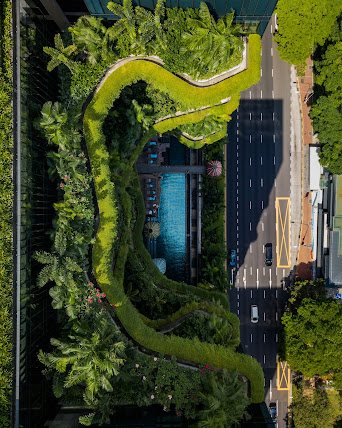Enhancing Climate Sustainability through Biophilic Design
In the face of rapidly changing climate conditions and the urgent need for sustainable solutions, biophilic design has emerged as a promising approach that merges architecture, urban planning, and environmental consciousness. This design philosophy recognizes the importance of human-nature connection and integrates natural elements into the built environment. By combining the principles of biophilic design with climate sustainability goals, we can create spaces that not only mitigate the impacts of climate change but also promote human well-being and ecological balance.

Energy Efficiency:
Biophilic design offers numerous strategies to enhance energy efficiency in buildings. By optimizing natural lighting through strategic placement of windows, skylights, and lightwells, buildings can reduce the need for artificial lighting during the day. Incorporating natural ventilation systems and utilizing passive design techniques, such as shading devices and building orientation, helps minimize reliance on mechanical cooling and heating, thus lowering energy consumption and reducing greenhouse gas emissions.

Carbon Sequestration:
Biophilic design offers a remarkable opportunity for carbon sequestration, a crucial aspect of climate sustainability. By incorporating extensive green spaces, vertical gardens, and urban forests, biophilic design enhances the overall capacity of cities to absorb carbon dioxide (CO2) from the atmosphere. Through photosynthesis, plants capture CO2 and store it as biomass, thus reducing its concentration and mitigating climate change. This approach not only offsets carbon emissions but also enhances the aesthetic and ecological value of urban areas. Furthermore, the use of sustainably sourced timber in construction materials can contribute to carbon sequestration by locking carbon within the built environment.

Natural Stormwater Management:
Traditional stormwater management systems often struggle to cope with the increasing frequency and intensity of rainfall events resulting from climate change. Biophilic design provides sustainable alternatives by integrating green infrastructure elements. Features such as rain gardens, bioswales, and permeable surfaces help capture, store, and filter rainwater, reducing the burden on drainage systems. This approach not only prevents flooding but also replenishes groundwater supplies, promoting water resilience. By minimizing stormwater runoff and preventing water pollution, biophilic design supports the health of ecosystems and enhances climate resilience.

Urban Heat Island Mitigation:
Urban areas experience elevated temperatures due to the abundance of concrete and asphalt, known as the urban heat island effect. Biophilic design serves as a powerful tool to counteract this phenomenon. By incorporating green spaces, such as parks, green roofs, and street trees, biophilic design creates natural cooling mechanisms. Vegetation provides shade, cools the air through evapotranspiration, and reduces surface temperatures, mitigating the heat island effect. The creation of cooler microclimates through biophilic design not only enhances comfort for urban dwellers but also reduces the energy demand for cooling, leading to a significant reduction in carbon emissions.

Biodiversity Conservation:
Biophilic design contributes to biodiversity conservation in urban environments, which is vital for climate sustainability. By integrating native vegetation, creating habitat features, and preserving green spaces, biophilic design supports wildlife and enhances ecological balance. Urban biodiversity provides essential ecosystem services, such as pollination, pest control, and air purification, which are crucial for climate resilience. Diverse ecosystems are more resilient to the impacts of climate change, ensuring the long-term sustainability of urban environments. By preserving and promoting biodiversity through biophilic design, we can foster a harmonious coexistence between humans and nature
As climate change continues to shape our planet, the need for sustainable design approaches becomes increasingly critical. Biophilic design offers a compelling solution that aligns human well-being, ecological integrity, and climate sustainability. By incorporating natural elements into the built environment, we can enhance energy efficiency, sequester carbon, manage stormwater sustainably, mitigate the urban heat island effect, and conserve biodiversity. As architects, urban planners, and policymakers embrace the principles of biophilic design, we move closer to a resilient and sustainable future, where human needs are met while fostering a deep connection with the natural world.


Comments
Post a Comment